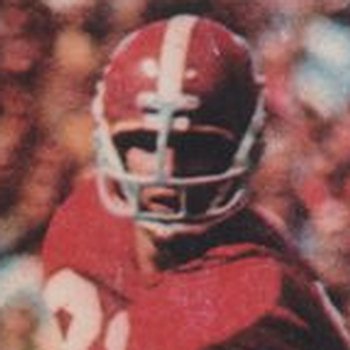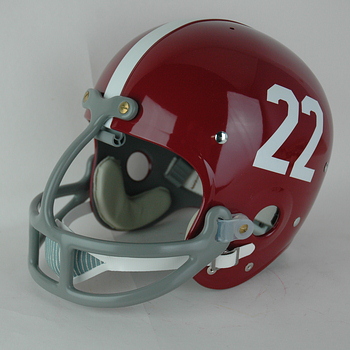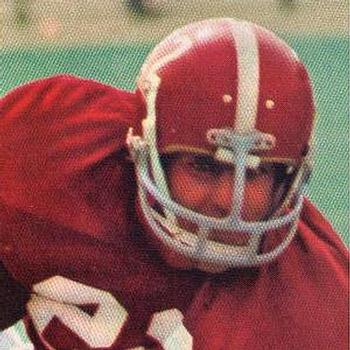

Alabama
1964-82 Crimson Tide
(Authentic Reproduction)
 |
 |
 |
 |
 |
 |
Alabama returned to the field for ’70 in their “as usual” cardinal helmet with one-inch white center stripe and three-inch white, plain block numerals on each side. They also gave their alternate white helmets with the cardinal one-inch center stripe and cardinal three-inch numerals a lot of exposure, wearing this headgear for the opening game against USC, and the next week against the maroon helmeted Virginia Tech Hokies. They put the white hat on against Houston on October 24th and wrapped up the season with it against Oklahoma in the December 31st Bluebonnet Bowl. Opening the 1970 season with an embarrassing 42-21 defeat at home to powerful University of Southern California and their superb fullback Sam Cunningham and a talented roster filled with many African American players has been the focal point of numerous articles and two books. This game is credited with exposing an African American star to the state’s populace and spurring the Alabama program to integrate. The twelve game schedule produced a 6-5-1 resume, a repeat of the mediocre showing of ’69, and the second consecutive losing record within the conference. The Bluebonnet Bowl 24-all tie with Oklahoma did little to add luster to the year’s summary although it did expose Bryant to the Wishbone and that would change college football history. Halfback Dave Brungard, an Ohio State transfer, augmented the 1137 rushing yards of All American Johnny Musso who was clearly the bellcow of the team. Still running a pro type offense, quarterback Scott Hunter was effective with tight end David Bailey again his primary target and Hunter moved on to a nine season pro term with the Packers, Bills, Falcons, and Lions. SEC heavyweight wrestling champion John Hannah paved the way at tackle and was All SEC. The defense was inconsistent but had emerging talent in weight trained linebacker Jim Krapf from Delaware, defensive end Robin Parkhouse, and linebacker Jeff Rouzie.
As the 1971 football season began, Coach Bryant had a surprise for the nation, an 11-0 regular season record and number two ranking until getting swamped by Nebraska in the January 1st Orange Bowl. The bigger surprise was the wholesale change and complete commitment to the Wishbone Offense, a change that was kept under wraps until the opening game of the season actually started. Making an off-season visit to his friend Darrell Royal at Texas, the great coach decided to install the Wishbone and refused to reveal this to anyone outside of his squad until the season’s opener against USC. Rolling up 302 yards on the ground in the 17-10 victory, Bryant’s 200th, set the tone for an otherworldly comeback from the 1969 and ’70 seasons with quarterback Terry Davis perfect for directing the new attack. Back-up Billy Sexton later became one of Bobby Bowden’s trusted assistants at Florida State for many seasons. Once again, with 1088 rushing yards, Johnny Musso was an All American with big John Hannah leading the blocking brigade and also granted the same All America accolades. Linebacker Krapf moved to the offensive line and was named All SEC tackle playing in tandem with All SEC center Jim Grammer. There was room for other offensive stars as unselfish David Bailey who was asked to become a blocking end rather than the accomplished receiver he had been, was named an All SEC end. He was ably supported by the other end Wayne Wheeler. Running backs Joe Labue and Ellis Beck shared some of the load with Musso. The defense was star-studded with defensive end Robin Parkhouse and linebacker Tom Surlas All Americans. Parkhouse spent a year with the Colts, another with the CFL and then fell victim to substance abuse before turning his life around, successful in family life, a contracting business, and a prison ministry. Transferring from Iowa’s Ellsworth JC, Mt. Pleasant, Pennsylvania product Surlas threw himself into the Alabama football culture and later played in both the CFL and with Memphis of the World Football League. Steve Higgenbottom an All SEC DB, linebacker Jeff Rouzie and 6’6” defensive end John Croyle also stood out. Rouzie, in later years would serve as Foley, Alabama’s Economic Development Director. John Mitchell, a two-time junior college All American out of Eastern Arizona JC who was an Alabama native, appeared as the first African-American player in an Alabama game program and added to the effectiveness of the defensive line. The Tide was crowned as the Southeastern Conference Champions, their first of five consecutive SEC titles and the first of eight it would garner in the 1970’s. The undefeated regular season ended with an Orange Bowl match-up that pitted number one Nebraska against number two Alabama. The 38-6 Husker victory left the Tide in fourth place in the polls as the Big Eight’s Nebraska, Oklahoma, and Colorado completed a sweep of the top three spots. Long-time fans would note that the Tide’s white helmets would be worn for the last time during the Bryant Era in ‘71’s games against USC, Vanderbilt, and finally, against Houston on October 23.
SPOTLIGHT ON JOHNNY MUSSO:
Referred to as “The Italian Stallion” long before actor Sylvester Stallone, Johnny Musso was a highly recruited star from Birmingham’s Banks High School. As a halfback that ran much harder than his 180 pounds would predict, he was a 1966 and ’67 All State selection and was named All Southern after his senior season. He had filled out his 5’11” frame to 188 pounds by the time of the Alabama State All Star Game and became a key component of the Tide offense entering his sophomore season. A first team All American in 1970, he rushed for 1137 yards, averaged five yards per carry, added thirty pass receptions, and threw for two touchdowns on the three passes he attempted for the season. At 194 pounds entering his 1971 senior season, he again claimed All America honors in Bryant’s new Wishbone Offense, gaining 1088 yards on the ground and leading the SEC in scoring with 100 points. His career total of thirty-four touchdowns set a Bama standard and his classroom work was just as sterling, named as an Academic All Conference member three times and twice as an Academic All American. Leading the Alabama Wishbone in his senior season, he finished fourth in the Heisman Trophy vote yet was named “National Player Of The Year” by more than one prestigious organization. He passed on the NFL and instead played with the British Columbia Lions in the CFL from 1972 through ’74 and returned to the U.S. and his hometown World Football League Birmingham Vulcans for the 1975 season. Slowed by a knee injury upon his return to U.S. football, he played with the Chicago Bears in 1976 and ’77 but was forced to retire in 1978 due to that injury. A member of the College Football Hall Of Fame and the Alabama Team Of The Century, Musso became a successful Chicago area commodities and futures trader who was very active in youth and church based charity work with his wife Tanner. Musso’s hard-charging style and exceptionally polite and humble manner has maintained tremendous popularity among long-time Alabama fans.
If interested in any of these Alabama helmets please click on the photos below.